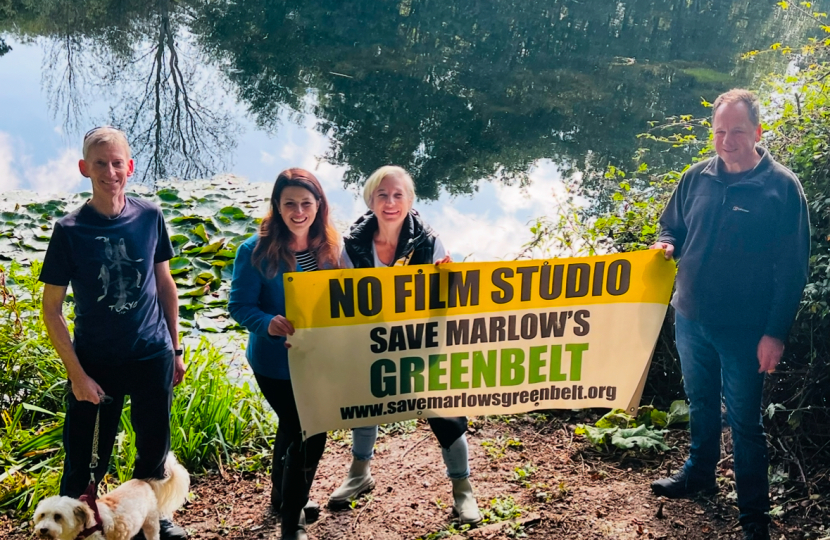This morning I was pleased to address the Inquiry into the Marlow Film Studios application.
I have been steadfast in my opposition - this is the wrong development, in the wrong location, with a weak and declining economic case.
Please find my full speech below:
Thank you for the opportunity to address the inquiry today.
I want to start by paying tribute to the many residents and Marlow groups that have gone before me in addressing this inquiry. I think they have set out calmly, professionally and with clarity why the original decision to refuse this application was the right one. It has been a genuine privilege to work with them over the last few years, leading to this moment.
Today, I want to set out the grounds on which I believe this appeal by the applicant should be dismissed. They are fivefold:
Failure to meet the high bar needed for release of Green Belt.
Weak and uncertain economic benefits
Conflict with the local development plan.
Wider development harms.
Lack of public support.
This application has consistently failed to meet the high bar required to relinquish Green Belt land and to get anywhere near mitigating the traffic impacts – despite the generous time Buckinghamshire Council and the Strategic Sites Committee afforded the applicants to have a second go when it was originally deferred.
Let me turn first to Green Belt and I quote from the planning officers report: It “would constitute inappropriate development and would result in very significant spatial and visual harm to the openness of the Green Belt and in the significant loss of open countryside and be in conflict with the fundamental purpose of the Green Belt policy”.
I have said this consistently from the outset in my own objections - and I agree with planning officers. The Green Belt matters and it is why the last Government further strengthened the protections afforded. It was grounds alone to reject the application at Strategic Sites Committee stage. It remains so.
Do not fall for the desperate argument that this is poor quality Green Belt – it is emphatically not, although no such subjectivity is relevant in any case. It is demonstrated by representations from statutory and other stakeholders as important Green Belt.
Now I believe the new Government is weakening Green Belt protections. I suspect the applicant’s appeal was in part emboldened by a belief that planning relaxations would come their way by the time of the inquiry. But even against the revised national planning policy framework on Green Belt, this application falls at the first hurdle. I know you will be familiar with the revised Green Belt provisions, but it seems appropriate to reiterate the 5 purposes of Green Belt:
a) to check the unrestricted sprawl of large built-up areas;
b) to prevent neighbouring towns merging into one another;
c) to assist in safeguarding the countryside from encroachment;
d) to preserve the setting and special character of historic towns; and
e) to assist in urban regeneration, by encouraging the recycling of derelict and other urban land.
This part of the Green Belt is clearly serving a number of those purposes and the original planning officer recommendation to the Strategic Sites Committee remains pertinent. I repeat:
It would constitute inappropriate development and would result in very significant spatial and visual harm to the openness of the Green Belt and in the significant loss of open countryside and be in conflict with the fundamental purpose of the Green Belt policy.
Now the key test remains as set out in 153 of the new NPPF:
When considering any planning application, local planning authorities should ensure that substantial weight is given to any harm to the Green Belt, including harm to its openness. Inappropriate development is, by definition, harmful to the Green Belt and should not be approved except in very special circumstances. ‘Very special circumstances will not exist unless the potential harm to the Green Belt by reason of inappropriateness, and any other harm resulting from the proposal, is clearly outweighed by other considerations.
The applicants have, it seems to me, persisted to try and argue that the economic case is their “clearly outweighed”. I will set out later that this has not only never been a tenable position, but it has now disappeared without a trace thanks to the economic and market realities set out just last week by Pinewood Studios.
We then have 154 and 155 of the revised NPPF to consider in terms of appropriate development in the Green Belt. This application meets none of the criteria in 154.
It also meets none of the criteria of 155 either. Taking two specific areas: In respect of a) this land has not been designated as grey belt and in b) there is no unmet need as Pinewood Studios and other studios exist in the locality and indeed are now under-utilised.
Let me turn now to the key myth I want to bust – that there is an economic case for this development. The film industry has and is a significant contributor to the UK economy and I am proud to support the fantastic film school in my constituency that helps produce so much of the talent for that industry. But this is an industry where the demand for film studios is falling, and this development simply will not create local jobs. Let me turn first to demand. As I set out in my contribution to the Strategic Sites Committee when it considered this application, according to British Film Institute data, HETV and film production fell 40% in 2023. The latest figures from the BFI clearly show that the UK production industry is continuing to suffer. Full year expenditure for 2024 is lower than anticipated and growth remains weak.
Whilst feature film production appears to have recovered from the Hollywood strikes, spending on High End Television is well below the peaks seen in 2022. This reflects the structural changes taking place within the streaming industry. Changes that I believe will have a long-term impact on UK inward investment. The demand trend is emphatically downwards – and with so many film studios already in our vicinity, the case for a further studio is simply not there. These studios by their very nature also have most people coming in from across the country and from overseas, then leaving post production– meaning it will not create local jobs.
We also now have a very specific proof point that demand for studios is falling. Pinewood Studios issued a press release on 30th January announcing a public consultation on shifting the focus on its planned expansion away from studio growth to a mixed use development due to falling demand with the CEO saying:
“We are a dynamic business in a fast-moving industry, and we are committed to invest in the ongoing expansion of Pinewood Studios. The reduction in global content production, combined with rising construction costs and business rates, triggered a review of our existing planning consent and we believe the revised proposals provide a credible alternative.”
So Pinewood – an established world renowned studio has had to change its expansion plans due to falling demand. Where does the applicant think its demand will come from?
I noted that during this inquiry the applicant’s economic expert had to guide that their own estimate of 4000 jobs was unreliable. I would argue it is not unreliable; it is simply not going to materialise.
This gets to the heart of the weakness of this application – even if you don’t share my own view that the economic case is weak, the reality is that the economic case is at best uncertain, unreliable and prone to market changes. Pinewood is a real, near and compelling proof of this fact. To allow a film studio to meet the high bar needed to release Green Belt, lose that Green Belt but then find an unused studio irreversibly in place – would be wrong and catastrophic.
The applicants have never been able to answer this basic question – of all the potential sites for a film studio in the UK, is there really only this patch of Green Belt available?
But this application also then fails other key tests. The traffic impacts are severe and significant – and the applicant has failed time and time again to grasp the magnitude of the disruption this would have on Marlow and the surrounding area. This is because it simply cannot be mitigated. This is a further ground for refusal, as Buckinghamshire Highways have set out.
The NPPF again sets out clearly that developments in the Green Belt also need regard to both 110 and 115:
110. The planning system should actively manage patterns of growth in support of these objectives. Significant development should be focused on locations which are or can be made sustainable, through limiting the need to travel and offering a genuine choice of transport modes. This can help to reduce congestion and emissions and improve air quality and public health. However, opportunities to maximise sustainable transport solutions will vary between urban and rural areas, and this should be taken into account in both plan-making and decision-making.
115. In assessing sites that may be allocated for development in plans, or specific applications for development, it should be ensured that: a) sustainable transport modes are prioritised taking account of the vision for the site, the type of development and its location; b) safe and suitable access to the site can be achieved for all users; c) the design of streets, parking areas, other transport elements and the content of associated standards reflects current national guidance, including the National Design Guide and the National Model Design Code48; and d) any significant impacts from the development on the transport network (in terms of capacity and congestion), or on highway safety, can be cost effectively mitigated to an acceptable degree through a vision-led approach.
This application demonstrably fails both these tests despite having months to try and find ways to meet them. It couldn’t, because this is the wrong development in the wrong location.
There are then also the harms that were set out so clearly and compellingly by the planning officers and accepted by the Strategic Sites Committee – to the AONB, to Little Marlow Country Park and to heritage to name but a few. Crucially – it is in contrary to 5 local development plan policies. That local plan matters and should be of significant weight to the decision.
Finally, I hope over the course of this inquiry it has become clear – this development is strongly opposed by my constituents. The weight of individual objections is clear. The Parish poll was decisive. Let me briefly say that Parish Poll was extraordinary. I know a bit about getting people to vote in elections – it’s not easy. The turnout was comparable to local government by-elections despite a significantly shorter time period to vote, no polling cards issued to remind people, no postal votes. The result was emphatic and decisive.
So, to conclude. Green Belt test not met either before the revised NPPF or after. Traffic impacts not mitigated. Conflicts with 5 policies of the local development plan. Harms to the AONB, Little Marlow Country Park and residential amenity. An economic case that is weak and worsening and blown away by the practical realities put in the public domain by an established, world renowned studios just a few miles away.
This has always been a bad application with little future. The wrong development, at the wrong time, in the wrong location, causing significant harms. I hope that you will dismiss this appeal, bring a final end to this application and allow this Green Belt land to be retained.


